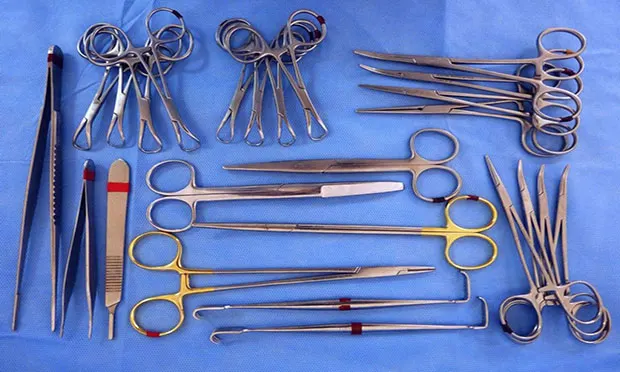The Basic Surgery Kit

Considering the virtually limitless range of surgical instruments, it can be difficult to assemble a cost-effective basic surgery kit. Some instruments may misleadingly appear multipurpose, but their misuse may damage them, leading to unnecessary replacement costs or, worse, intraoperative accidents putting the patient’s safety at risk. Many instruments are available in different qualities and materials (eg, tungsten carbide instruments—more expensive but much more resistant to wear and corrosion than stainless steel) and varied sizes to match the purpose of their use as well as the size of the surgeon’s hand.
Minimal Basic Surgery Kit
Scalpel
Figure 1. A. No. 3 and No. 7 scalpel handles. B. Nos. 10, 11, and 15 disposable scalpel blades (top to bottom).

The scalpel is an indispensible item in a surgical kit designed to make sharp incisions. Scalpel incision is the least traumatic way of dissection, but provides no hemostasis. Scalpel handles come in various sizes, each accommodating a range of disposable blades (Figure 1). Entirely disposable scalpels are also available.
Scissors
Figure 2. A. Mayo, Metzenbaum, and suture scissors. B. Langenbeck and Senn-Miller hand-held retractors (top to bottom).

Scissors are used for cutting, albeit with some crushing effect, and for blunt dissection. Fine scissors, such as Metzenbaum scissors (Figure 2), should be reserved for cutting and dissecting delicate tissues. Sturdier scissors, such as Mayo or suture scissors, are designed for use on denser tissues (eg, fascia) or inanimate objects (eg, sutures, drapes). All scissors can be either straight or curved, the latter intended for keeping the hand out of the surgeon’s line of vision during use.
Grasping Instruments
Towel clamps
Towel clamps are designed to secure drapes to the patient’s skin. They are available in various sizes and with either penetrating or nonpenetrating tips. Towel clamps with penetrating tips can also be used for skin handling or temporary wound approximation during reconstructive procedures.
Needle-holders
Figure 3. Mayo-Hegar needle-holder.

Needle-holders are for manipulation of needles only. Their jaws are short and crosshatched to prevent any undesired movements of the needle during its passage through tissues. They are expensive and delicate instruments and therefore should never be misused (eg, for orthopedic wire twisting). Commonly used needle-holders are Mayo-Hegar and Olsen-Hegar (Figure 3). The latter combines needle-holders and scissors, minimizing instrument change but exposing to inadvertent cutting of the suture.
Ratcheted Tissue Forceps
Figure 4. A&B. Mosquito hemostats with a detailed view of the jaws. C&D. Carmalt forceps with a detailed view of the jaws.

These forceps are equipped with a ratchet that enables tissue manipulation without repeated grasping. They are also used for hemostasis, blunt dissection, and temporary hollow viscus occlusion. Their appropriate use can be determined by the design of their jaws, which can be straight or curved, smooth or serrated, or specifically shaped. Mosquito, Crile, and Kelly forceps are commonly used for occlusion of vascular pedicles. Carmalt forceps are suitable for spay procedures (Figure 4). Allis forceps and Babcock forceps have jaws specifically shaped for grasping tissues, and Doyen forceps have long smooth jaws designed for atraumatictemporary intestinal occlusion. Misuse of these forceps (eg, for grasping needles, orthopedic pins) can have serious consequences (eg, failure to hold occlusion of a large vascular pedicle).
Thumb Forceps
Figure 5. A. Debakey thumb forceps. B. Rat-tooth thrumb forceps. C. Brown-Adson thumb forceps with detailed view of the jaws.

Thumb forceps, held in a chop-stick fashion in the nondominant hand, are designed for accurate tissue handling without direct contact between surgeon’s fingers and tissue. They are also used to manipulate needles during suturing. Most commonly used thumb forceps are (listed from most to least traumatic): rat-toothed forceps, Adson forceps, Brown-Adson forceps, and DeBakey forceps (Figure 5). Atraumatic forceps are used on delicate tissues such as hollow organs, whereas more traumatic forceps are reserved for dense tissue such as fascia, aponeuroses, etc. A basic surgical kit should contain at least a pair of toothed and a pair of nontraumatic thumb forceps.
Retractors
Retractors help improve exposure and protect retracted structures. Retractors can either be hand-held (by an assistant) or self-retaining. Their use is determined by the size and shape of their blade(s). Long blades are used for retraction of deep tissues. Sharp-blade retractors limit accidental slippage of the retractor and are usually used on strong tissues (eg, fascia, muscles, and subcutaneous tissue). Blunt retractors are useful for retracting delicate and fragile tissues (eg, viscera) or a larger amount of tissues. Commonly used hand-held retractors are Senn-Miller and Langenbeck retractors (Figure 2). Self-retaining retractors designed to maintain body cavities open (eg, Balfour or Gossett retractors for abdominal surgery) are useful, especially when a surgical assistant is not available.
Other Equipment
Suction Unit & Tips
Figure 6. A. A suction unit. B. Yankauer, Poole, and Frazier suction tips (top to bottom). C. Electrosurgical unit. D. Unipolar and bipolar hand-piece.

A suction unit (Figure 6) is an invaluable tool used for removing blood and other body fluids from the surgical field. Copious rinsing of the surgical field or body cavities is essential for surgical conditions (eg, septic peritonitis), and complete retrieval of lavage fluids, which is mandatory, can only be achieved through the use of a surgical suction unit. The device consists of a negative pressure generator, containers, tubing, and various tips, which can be either disposable or reusable. The configuration of the suction tip determines its use: Frazier tips are designed for pin-point suction, while Poole and Yankauer tips are designed not to be occluded during suction from body cavities.
Electrocautery
Electrocautery devices use electric current to produce heat to cut tissues and cauterize vessels. They consist of a generator and various accessories connected by cables (hand-piece, dispersive plate, and foot switch). Unipolar electrocautery can be used forhemostasis as well as for cutting. Bipolar electrocautery can only be used for hemostasis, but it creates less collateral damage. Although relatively expensive, electrocautery is extremely worthwhile and almost mandatory to perform most soft-tissue surgeries with appropriate hemostasis and minimal complications (Figure 6).